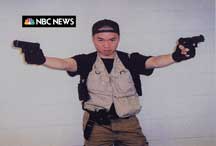Magazine
A Glance Away

| Within hours of the terrible tragedy at Virginia Tech University, long before Cho Seung-Hui’s identity became known, word was out on the street, blogs and the broadcast media that the perpetrator of the biggest campus violence in U.S. history was Asian.
Non-Korean Asians breathed a collective sigh of relief when he turned out not to be one of them, just as Koreans braced for the accompanying backlash. Even though Cho’s highly disturbed mental state came to light almost as instantly, stereotypical commentaries about academic pressures on Asians, their fears of failure and loner tendencies, etc. fanned in the media and blogosphere were inescapable. Since Virginia Tech is an engineering school, it should come as no surprise that fully a tenth of its students are Asian American or from Asia. Cho could as easily have been Chinese, or Vietnamese, or Indian. Those are statistical probabilities and social possibilities, although we do not wish them on any community. But one has to accept that there is a theoretical chance that could take a real life form. If and when that occurs, we have to be tuned into the fear that our fellow Asians, the Koreans, feel in the hours after news of this massacre broke. It is an experience known to them from the Rodney King riots in Los Angeles and to South Asians and Arabs in the aftermath of the Iran hostage crisis over two decades ago and 9/11 more recently. Ignorance is the fuel of hatred and vitriol. Tragically, now the peaceful environment of higher education has been turned into other suspect areas of American life. The ever-pleasant spotlight on Indian techies, physicians, Sanjaya Malakar, Sandeep Gupta, or Kalpana Chawla, illuminated the Indian identity without pain, a trifle amusement, good-natured ridicule, but mostly admiration. There is cuteness in the air when it comes to Indians. We are embedded deep in the fabric of American life now. |

 All minorities shiver in their spines after such violent events. They pray the perpetrator is not from among them. Had the murderer been Caucasian, it is doubtful if there would be any mention of his race. But God forbid if he turns out to be a minority, or worse a foreigner. The actions of an individual are hreflected upon his entire community. It is stereotyping at its worst, an ignorant view of the world, but it is in media vogue, and it isn’t going away.
All minorities shiver in their spines after such violent events. They pray the perpetrator is not from among them. Had the murderer been Caucasian, it is doubtful if there would be any mention of his race. But God forbid if he turns out to be a minority, or worse a foreigner. The actions of an individual are hreflected upon his entire community. It is stereotyping at its worst, an ignorant view of the world, but it is in media vogue, and it isn’t going away.